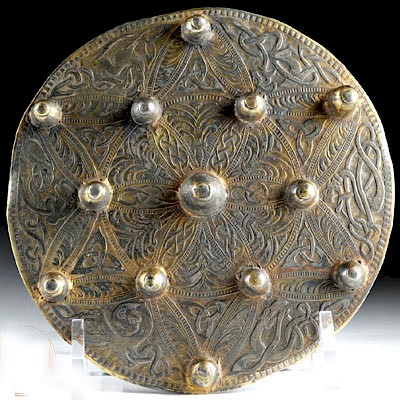Beautiful Roman / Byzantine Glass Pouring Vessel
Lot 47
About Seller
Artemis Fine Arts
686 S Taylor Ave, Ste 106
Louisville, CO 80027
United States
Selling antiquities, ancient and ethnographic art online since 1993, Artemis Gallery specializes in Classical Antiquities (Egyptian, Greek, Roman, Near Eastern), Asian, Pre-Columbian, African / Tribal / Oceanographic art. Our extensive inventory includes pottery, stone, metal, wood, glass and textil...Read more
Estimate:
$2,500 - $3,500
Absentee vs Live bid
Two ways to bid:
- Leave a max absentee bid and the platform will bid on your behalf up to your maximum bid during the live auction.
- Bid live during the auction and your bids will be submitted real-time to the auctioneer.
Bid Increments
| Price | Bid Increment |
|---|---|
| $0 | $25 |
| $300 | $50 |
| $1,000 | $100 |
| $2,000 | $250 |
| $5,000 | $500 |
| $10,000 | $1,000 |
| $20,000 | $2,500 |
| $50,000 | $5,000 |
| $100,000 | $10,000 |
| $200,000 | $20,000 |
About Auction
By Artemis Fine Arts
Jul 19, 2018
Set Reminder
2018-07-19 10:00:00
2018-07-19 10:00:00
America/New_York
Bidsquare
Bidsquare : Fine Antiquities/Ethnographic Art
https://www.bidsquare.com/auctions/artemis-gallery/fine-antiquities-ethnographic-art-3329
Featuring classical antiquities, ancient and ethnographic art from cultures encompassing the globe, plus fine art. Artemis Fine Arts info@artemisfinearts.com
Featuring classical antiquities, ancient and ethnographic art from cultures encompassing the globe, plus fine art. Artemis Fine Arts info@artemisfinearts.com
- Lot Description
Roman, Late Imperial to early Byzantine period, ca. 5th to 7th century CE. A stunning and delicate yellow-green glass pouring vessel with a concave base and rough pontil scar, hexagonal body, a plateaued shoulder, a tubular neck, and an in-folded rim. A gently-curving trail handle joins both rim and shoulder with a sinuous excess trail coiling around the midpoint of the neck. The body exhibits six relief-molded panels with three pairs of matching patterns in a dense lattice, diamond forms with central circles, and stalky palm fronds. The vessel's yellow-green coloration imbues it with a calming presentation evocative of a natural landscape, and is nicely complemented by thick areas of fiery rainbow-hued iridescence. Size: 3.375" W x 5.3" H (8.6 cm x 13.5 cm).
Ancient glass manufacture had begun in the 2nd millennium BCE in Mesopotamia and Egypt. The Greeks and Phoenicians advanced glass technology greatly in the latter 1st millennium BCE. In the early 1st century CE, Roman workshops began producing blown glass on a large scale. Eventually glass vessels came to replace a wide variety of pottery and metal wares in the ancient world. Ancient Roman glass was traded far beyond the Roman Empire. Roman glass vessels have been found in Scandinavia, India, and in Han Dynasty tombs in China.
For a similar example of pattern-molded designs in a different color, please see The Metropolitan Museum of Art, accession number X.243: https://www.metmuseum.org/art/collection/search/256767
Provenance: private East Coast, USA collection
All items legal to buy/sell under U.S. Statute covering cultural patrimony Code 2600, CHAPTER 14, and are guaranteed to be as described or your money back.
A Certificate of Authenticity will accompany all winning bids.
We ship worldwide and handle all shipping in-house for your convenience.
#133181Surface wear and abrasions commensurate with age as expected, with some flaking to iridescence, otherwise intact and near-choice. Nice earthen deposits as well as rainbow iridescence throughout.Condition
- Shipping Info
-
All shipping is handled in-house for your convenience. Your invoice from Artemis Gallery will include shipping calculation instructions. If in doubt, please inquire BEFORE bidding for estimated shipping costs for individual items.
-
- Buyer's Premium



 EUR
EUR CAD
CAD AUD
AUD GBP
GBP MXN
MXN HKD
HKD CNY
CNY MYR
MYR SEK
SEK SGD
SGD CHF
CHF THB
THB

















